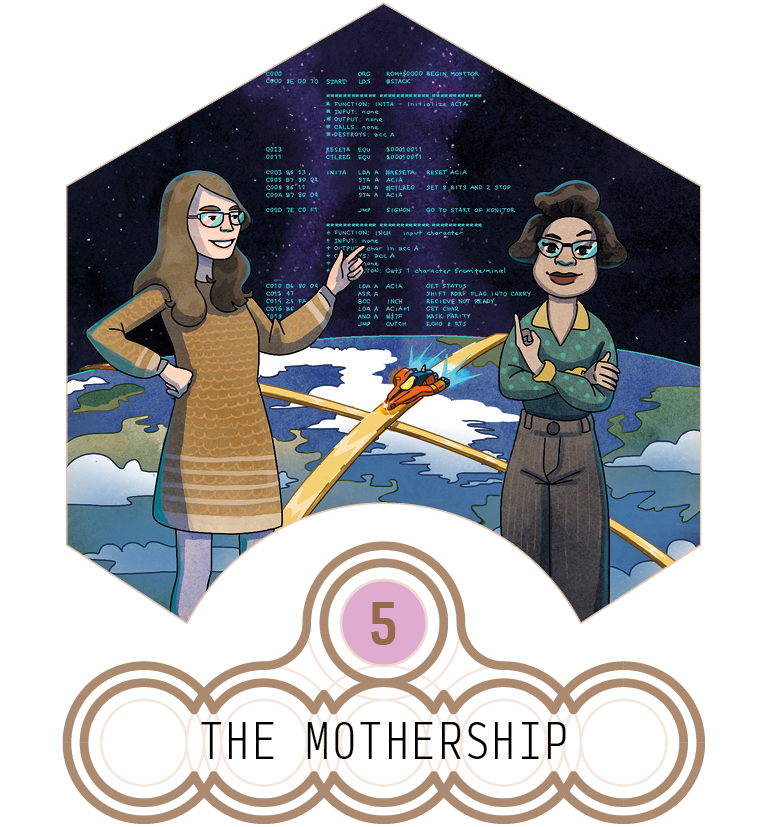
48°12‘37.4″N 16°21’18.1″E
48.210392, 16.355035
Alarm, alarm! The red light was flashing continuously now. Oh God she hoped the system would hold. Something had triggered the radar system just in time before the landing sequence needed to be calculated. It had sent the guidance computer into overdrive. “3 Minutes to landing”, a voice announced through the speakers in the control room. “This is not the time for that!”, she thought exhaustedly. She had programmed the computer to prioritise tasks that were essential for the landing process to work. The radar system wasn’t, and still it had triggered an overflow state. The computer could not process any more calculations. She just hoped her programme would work. Printed onto paper, the code for it was taller than her, there was enough room for error, for bugs in the code. Software engineering was complex. But now was not the time for errors. There was nothing she could do now. The shuttle was far away in space. The programme was running. “2 Minutes to landing”, the voice said.
She tried to focus on something positive. Her first day at work maybe. Yeah, her first day at work.
Her first day at work at the command center was glorious. “So this is where we drive this thing?”, she thought. But of course not, the earth drove itself. It had fully integrated stabilizers and a gravity system that kept all elements on board. She’d spent her whole life up until that point studying the earth and the skies above it. As head guidance programmer it was her job to make sure small versions of the mothership could navigate space safely. She called them spacecrafts.
Maggie was one of the most skilled software engineers at MIT and working for NASA had been a dream of hers. She was sure it was the right place for her. Always had been.
Ten years earlier, same place, Kathy, had a very similar experience. Except she hadn’t programmed anything, she had computed it. She had calculated several trajectories of Apollo’s testing missions. And now John Glenn was asking for her. The IBM 7090 computer had calculated today’s mission, but Glenn, its astronaut, was adamant that he wanted Katherine to compute the re-entrypoint of the spacecraft. The trajectory back to earth. Back to the safety of the mothership. It took days to check the calculations by hand. Just thinking about it made her nauseous. So she didn’t. She just didn’t think, she just calculated. And indeed. There it was. An error. THE error. The IBM computer had made an error and she had found it. She was elated and terrified at the same time. How could one person feel such complex emotions? She was sure there wasn’t enough room in her being for the emotional rollercoaster ride she was on.
And then the speaker ripped Margaret out of her thoughts and back into reality. “A small step for man, a giant leap for mankind”, it said and with that the room exploded with cheers, her colleagues were hugging her and shouting “Maggie, we’ve done it, we flew to the moon!”. Her mind was pulled back to earth, back to the command center. She had done it, her programme had flown the first person to the moon.
In the preparations to that momentous day the room was much quieter, when the Friendship 7 Mission was at the point of re-entry, returning home after the first orbit around the earth. Katherine couldn’t move, but all she wanted was to run, as far away as possible. She had found the mistake. But had she maybe missed another? Or possibly even made one herself and the error she re-calculated hadn’t even been one in the first place? And then, after 4 hours, 55 minutes, and 23 seconds the Friendship 7 spacecraft splashed down in the ocean. She had been correct. Glenn survived and had become the first person to orbit the earth. He had trusted her with his life, her of all people, Katherine Johnson of the West Area Computing Unit.
Later, when they both saw the first picture of the mothership from space, they thought to themselves, “that’s our first selfie”. The vastness of the space station could only be understood from the outside. From far away. Earth – a round ball floating in space, with a crew of 9 billion.